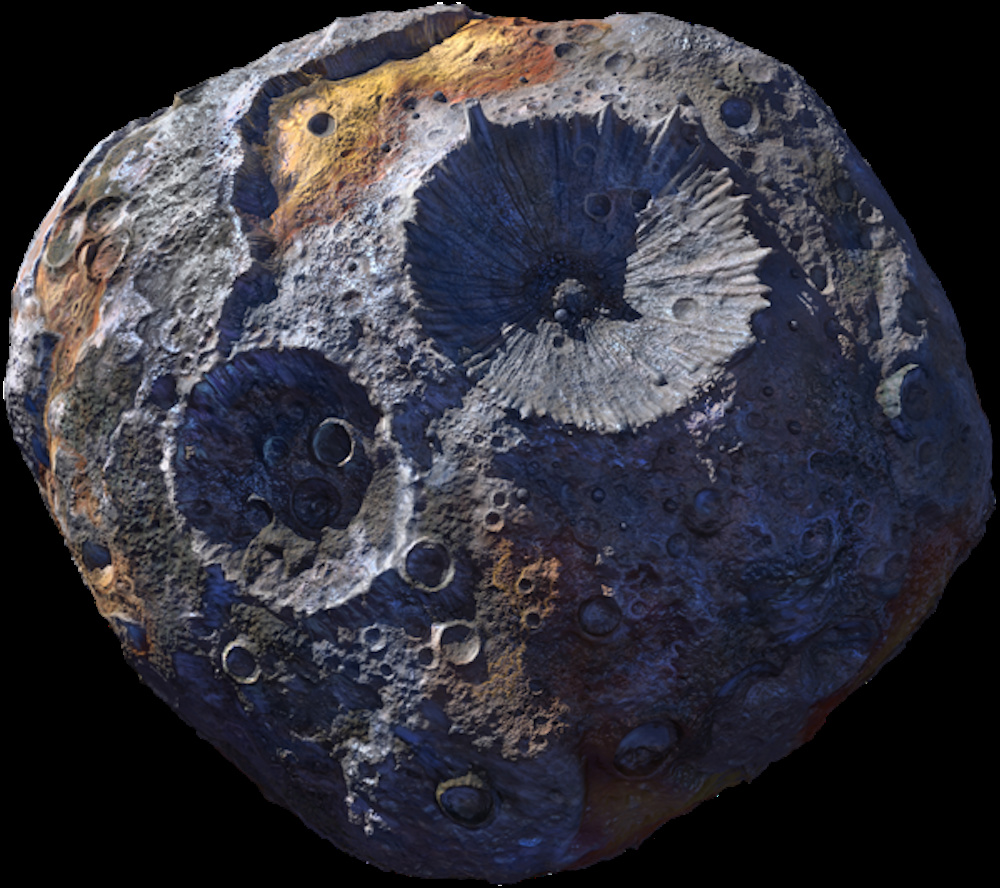
Planetary geologist VALERIE PAYRÉ looks, in an article first published on The Conversation, at how the push to find out more about asteroids could open up new mining opportunities…
The cars, cellphones, computers and televisions that people in the US use every day require metals like copper, cobalt and platinum to build. Demand from the electronics industry for these metals is only rising, and companies are constantly searching for new places on Earth to mine them.

The Psyche asteroid. PICTURE: NASA/JPL-Caltech/ASU
Scientists estimate that lots of these metals exist thousands of miles beneath Earth’s surface, in its molten core, but that’s far too deep and hot to mine. Instead, some companies hope to one day search for deposits that are literally out of this world – on asteroids.
The commercialisation of asteroid mining is still a ways off, but in October, 2023, NASA launched a scientific mission to explore the metal-rich asteroid Psyche. The main goal of the mission is studying the composition and structure of this asteroid, which could tell scientists more about Earth’s core since the two objects might have a similar makeup.
Both likely contain platinum, nickel, iron and possibly even gold – materials of commercial interest. Experts need to know what’s out there on asteroids before considering whether they’re worth mining. NASA’s Psyche mission could answer some of these questions.
I am a planetary geologist whose work explores other planets and astronomical objects like Mars, Venus and the Moon. I will be following the Psyche mission closely, as this is the first time that scientists will be able to learn about the composition and structure of a possible piece of a planetary core similar to the Earth’s, without indirect seismic or magnetic measurements, or replicating the pressure and temperature conditions of the Earth’s core in our labs.
With the spacecraft estimated to arrive at the asteroid’s orbit in 2029, the findings from the Psyche mission will provide unique insights into the type of metals present on the asteroid’s surface, as well as their amount, and the minerals containing these metals. This data is essential both for scientists like me exploring the formation and evolution planetary bodies, as well as for companies investigating the possibility of asteroid mining.
Asteroid formation
Asteroids come in a variety of sizes. Some are the size of a town, while others are the size of a state. Most asteroids are made of rocks and represent the leftovers from the early formation of our solar system around 4.6 billion years ago.
Not every asteroid is the same – some, like Bennu, the target of NASA’s OSIRIS-REx mission, are rich in carbon. These are very old, and they will teach scientists more about how planets formed and how life may have begun on Earth.
Others, like Psyche, are made of metals and potentially result from one or more collisions between astronomical objects when the solar system was forming. These collisions left debris flying through space — including potential pieces of a planet’s metal-rich core. A NASA spacecraft will orbit and analyse the surface of Psyche.
Mining in space
Not every mineral deposit on Earth is mineable. Companies first look for deposits with a high level of metal purity. They also investigate how affordable and feasible extracting the metal would be before choosing where to mine.
Similarly, before mining an asteroid, companies will have to think about all those factors, and they’ll have to come up with the infrastructure needed to mine at a distance and transport the metals they mine hundreds of millions of miles back to Earth. The technology to do that is still years away, and transporting metals would require major funding.
A few companies around the world have already started to think about what the best and lowest cost approach would be, drawing from processes similar to those used on Earth.
We rely on our readers to fund Sight's work - become a financial supporter today!
For more information, head to our Subscriber's page.
The first step would be finding a mineable metal deposit. Next, they’d drill and extract the metals on the asteroid. One of the most important differences with Earth mines is that each step would be undertaken remotely with spacecrafts orbiting around the asteroid and robots landing on its surface. Then, a spacecraft would send the resulting materials back to Earth.
Asteroid mining plans are still at their earliest stages. A few companies like Planetary Resources and Deep Space Industries, with goals to extract metals from space, were acquired by other companies.
Experts can’t quite tell yet how acquiring valuable metals from asteroids would affect the global economy, but these metals could potentially flood the market and lower their values.
The Psyche mission is a huge step in figuring out what sort of metals are out there, and it may also answer questions about the composition and properties of Earth’s core.![]()
Valerie Payré, is assistant professor of Earth and environmental sciences at University of Iowa. This article is republished from The Conversation under a Creative Commons license. Read the original article.






